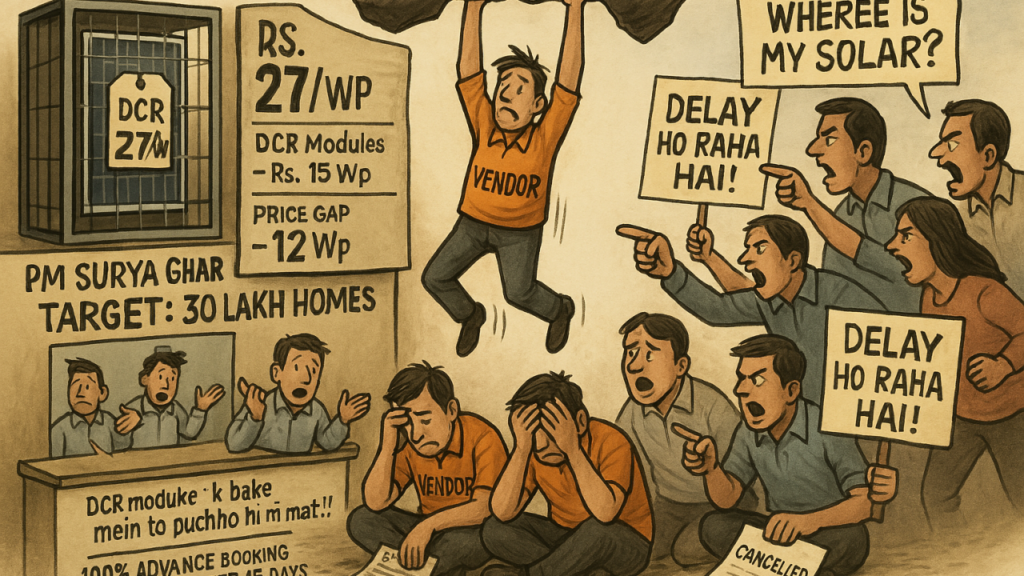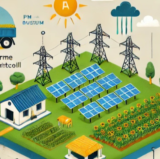
The PM Surya Ghar Muft Bijli Yojana was launched as a visionary step to empower 1 crore households with free electricity through rooftop solar. While the intention is commendable, the implementation — especially the mandatory use of DCR (Domestic Content Requirement) modules — is proving to be counterproductive.
Table of Contents
ToggleInstead of enabling affordable clean energy access, the scheme is becoming a vehicle for price inflation, artificial scarcity, and market distortion, where the real beneficiaries are a handful of domestic manufacturers — while consumers, small installers, and the ecosystem at large suffer.
❗ The Core Problem: The DCR Mandate
To promote local manufacturing, the scheme mandates the use of DCR modules. But this one policy decision is causing massive disruptions:
- Prices of DCR modules are significantly higher than non-DCR
- Availability is limited and controlled by a few players
- Small businesses and consumers are being priced out or delayed
Let’s break down the numbers.
📊 DCR Price Hike – Consumers Paying the Price
Year 1 (2023-24):
- Installations: 30 lakh homes (~3 GW = 300 Cr Wp)
- Price gap: ₹10/Wp → Additional burden: ₹3,000 Cr
- With 12% GST: ₹3,360 Cr
Year 2 (2024-25 Target):
- Target: 30 lakh more homes (~9 GW = 900 Cr Wp)
- Price gap: ₹12/Wp → Additional cost: ₹10,800 Cr
- With GST: ₹12,096 Cr
Year 3 (2025-26 Projection):
- Target: 60 lakh more homes (~18 GW = 1800 Cr Wp)
- Price gap: ₹15/Wp → Additional cost: ₹27,000 Cr
- With GST: ₹30,240 Cr
📉 Total extra consumer cost over 3 years: ₹45,000+ Cr
At the same time, the government claims to be offering ₹60,000 Cr as a subsidy. But more than 75% of that is being pulled back indirectly through inflated module prices and taxes. The real “subsidy” is ending up in manufacturers’ pockets.
❌ The Availability Crisis
What’s worse — even if consumers and installers are ready to pay the higher price, DCR modules are simply not available. Reports from the ground include:
- Artificial scarcity
- Hoarding by large EPC players
- Delays in supply and installations
This scarcity benefits no one except large manufacturers with capacity and control over distribution.
⚖️ A Lopsided System
- ✅ Winners: DCR Module Manufacturers
- ❌ Losers:
🛑 A Call to Pause and Reform
This is not how a pro-consumer, pro-green energy policy should function. It’s time for the government to pause the current scheme, evaluate the ground realities, and make essential reforms.
✅ What Needs to Change:
- Remove mandatory DCR for residential rooftop, allow BIS-certified non-DCR modules
- Ensure transparent pricing and availability
🌞 Let’s Make Solar Work for Everyone
India needs solar power — but not at the cost of fairness and accessibility. The PM Surya Ghar Yojana, in its current form, is deeply flawed. Instead of promoting clean energy, it is creating a closed market where consumers and small businesses are suffering.
Read more about Govt Approves Two New Payment Methods for Rooftop Solar Under PM Surya Ghar
It’s time for a course correction. Let’s build a rooftop solar ecosystem that is inclusive, efficient, and genuinely beneficial to the people it claims to serve.



